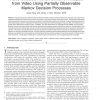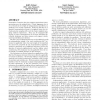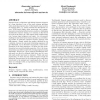13214 search results - page 2634 / 2643 » Pseudorandomness for network algorithms |
TON
2002
13 years 7 months ago
2002
Popular content is frequently replicated in multiple servers or caches in the Internet to offload origin servers and improve end-user experience. However, choosing the best server ...
NECO
2007
13 years 7 months ago
2007
Learning agents, whether natural or artificial, must update their internal parameters in order to improve their behavior over time. In reinforcement learning, this plasticity is ...
PAMI
2007
13 years 7 months ago
2007
—This paper presents a method for learning decision theoretic models of human behaviors from video data. Our system learns relationships between the movements of a person, the co...
PVLDB
2008
13 years 7 months ago
2008
Summaries of massive data sets support approximate query processing over the original data. A basic aggregate over a set of records is the weight of subpopulations specified as a ...
PVLDB
2008
13 years 7 months ago
2008
Sequence data is ubiquitous and finding frequent sequences in a large database is one of the most common problems when analyzing sequence data. Unfortunately many sources of seque...



